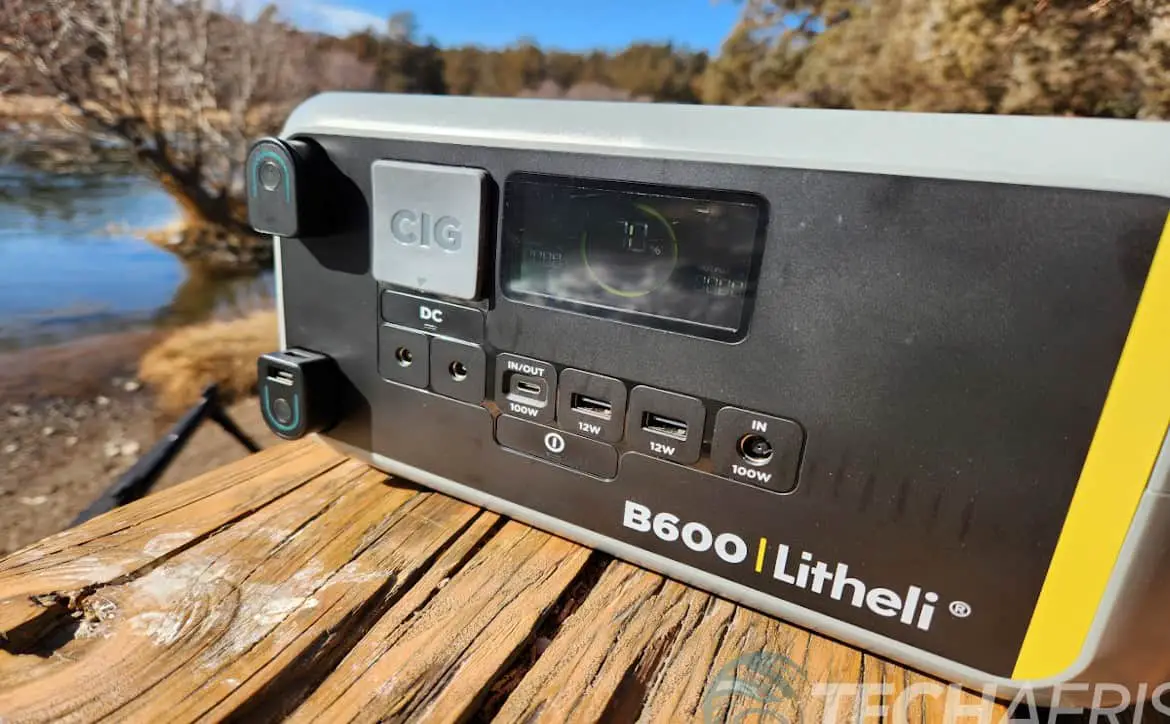
The world we live in is becoming more and more unpredictable. Over the last few years, we have seen an ever-increasing number of power outages across the U.S. and the world. The added strain to the already aging grid and extreme weather are constantly putting us in situations that can cost us thousands of dollars in food and extreme cases, even cost lives. Having some sort of portable power station in your home for emergencies can make a huge difference. They can also be really handy to have for traveling, your backyard, the shed, road trips, the job site, or any other situation where a little traditional power would be handy. The Litheli B600 is another power hub or solar generator that can offer you peace of mind and brings in a unique U-Battery ecosystem that could make a bit of van life/off-grid living a little simpler.
Estimated reading time: 21 minutes
Let’s hop into my experiences with the Litheli Power Hub B600, their portable solar panel, and a cool little handheld vacuum to see what sets it apart from other solar generators on the market.
Table of contents
Specifications
Battery Info
- Battery Capacity: 562wh with the B600 and 32Wh provided by 2 U-Batteries (16Wh each)
- Battery Type: Li-ion NMC (Lithium-Nickel-Manganese-Cobalt-Oxide)
- Life Cycles: 500 cycles to 80%+ capacity or 1.3 years if used daily.
- Shelf-Life: Discharge and recharge every 3 months. Store at 85%. Store between 32°F and 113°F.
Outputs
- 2 AC Output: 600W (rated power) 1,200W (peak) Pure-Sine Wave
- 2 USB-A Output: 12W (peak), 5V-2.4A
- 1 USB-C Output: 100W (peak), 20V-5A
- 1 Car Output: 136W (peak), 13.6V-10A
- 2 DC5521 Output: 136W (peak), 13.6V-10A
- 1 Wireless Charger: 15W (peak)
Inputs / Charge Times
- AC Charging: 100W (peak), fully recharged in 6 hours
- Solar Charging: 100W (peak) 8A, fully recharged in 6 hours
- Car Charging: 100W (peak), fully recharged in 6 hours
- Dual Charging: (AC + Solar): 200W (peak), fully recharged in 3 hours
General
- Dimensions: 12.32 x 8.03 x 6.65 in
- Weight: 13.23 lb.
- Noise Level: 55 dB when the fan is on. Sound is equivalent to a household fridge.
What’s in the Box
- Litheli Power Hub B600
- 100W Type-C Power Adapter
- Type-C to Type-C Charging Cable
- MC4 to D7909 Solar Charging Cable (5 foot)
- Vehicle Charger (5 foot)
- 2 U-Batteries
Design
The Litheli Power Hub B600 strays away from your traditional square box slightly with a rear protruding handle that spans the length of the device. It is easy to grab but does lack any type of texture or rubber gripping. The B600 weighs in at 13.23 pounds and isn’t cumbersome to hold or carry anyways.
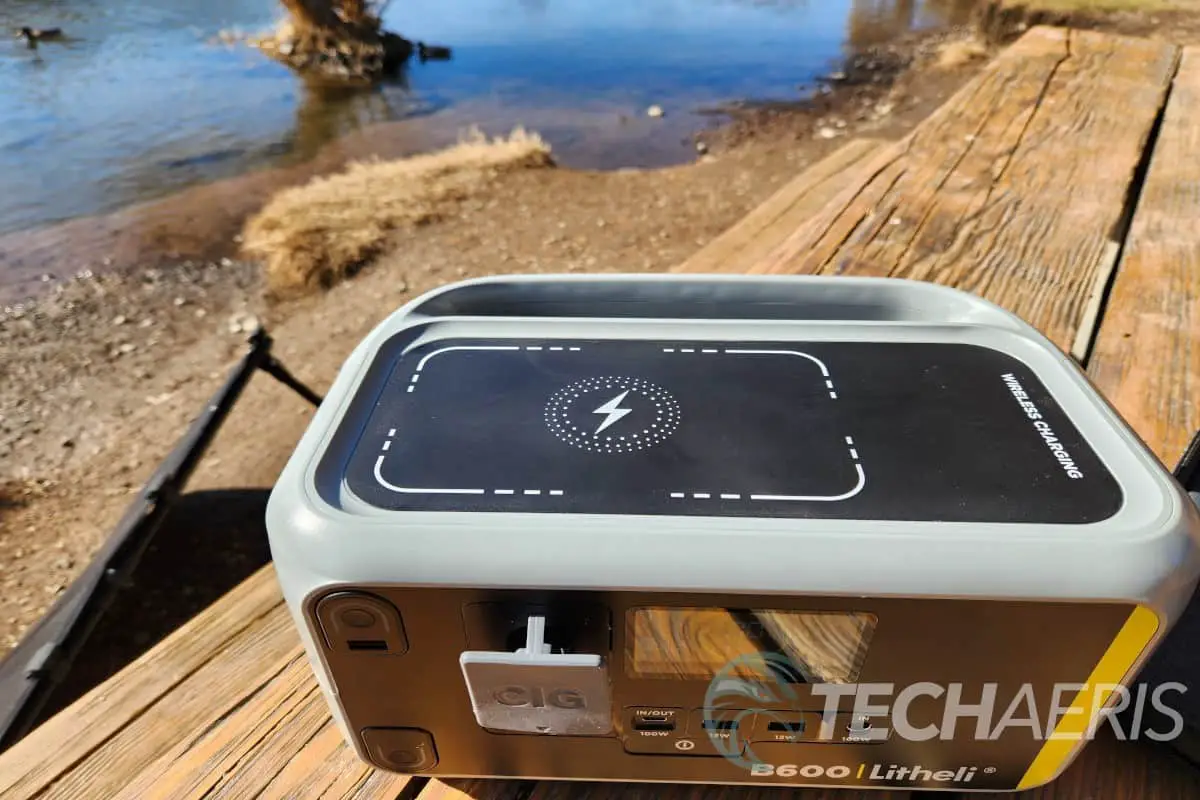
At the top of the unit is where you will find a large indented platform that houses the 15W peak wireless charging pad. Interestingly enough, the coil is slightly elevated, and you can feel it when you run your fingers across the charging pad. You will also notice it when you place your QI-enabled device on it to charge. Most other brands out there are flush and can sometimes be a bit trickier to place your device on properly. This slight bulge makes it pretty easy to center your device.
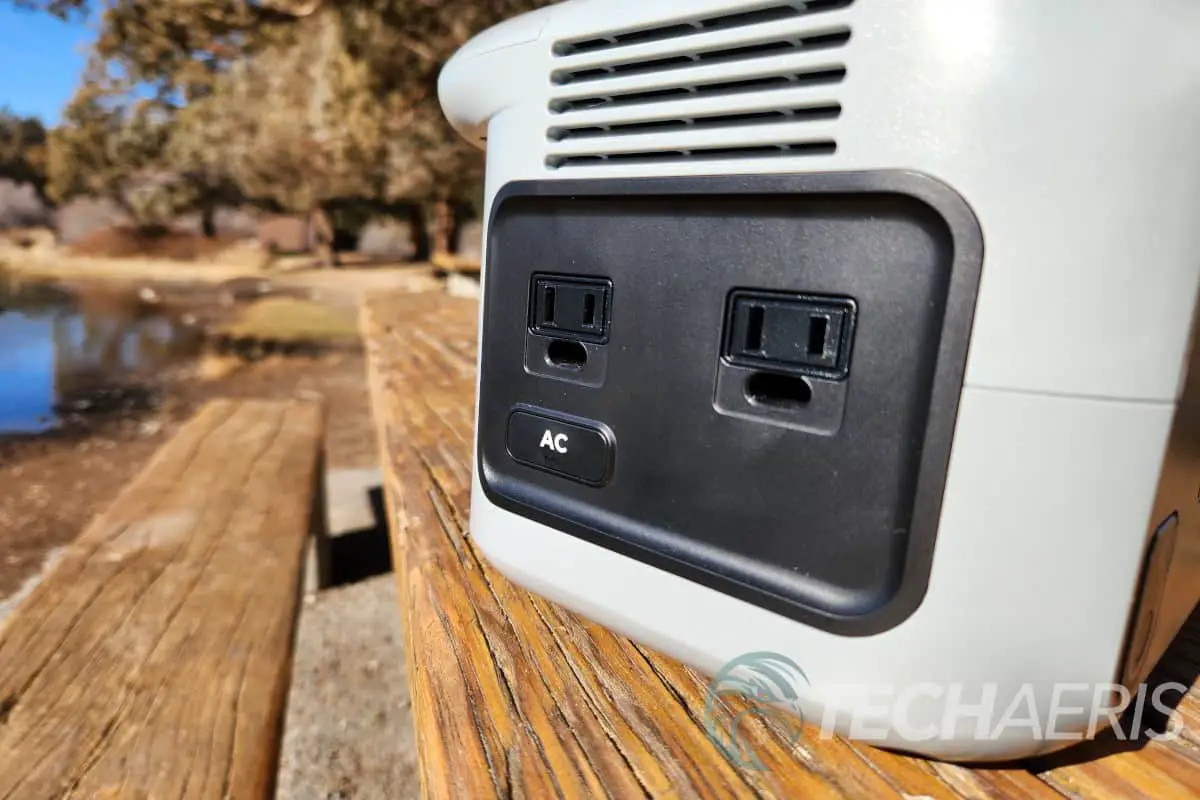
On the left-hand side, you will find a pair of AC plugs and the AC power button to activate the 600W Pure-Sine Wave inverter. When turned on, there is a white light that illuminates under the AC text. It is much brighter than the lights that illuminate for the power, and DC found on the front of the unit. You hear the fans kick on immediately upon turning it on, but it is faint. If you are sitting next to it in a quiet room, you will hear the hum. Placing my phone next to it with a sound meter app, it registered 36-40 dBs compared to the ambient room sound of 29-32 dBs. Basically, like a fridge running or your computer’s internal fans. Above the AC plugs are a series of slots for ventilation. The right side also offers a series of slots for more ventilation.
The rear of the unit is blank, and the bottom offers two large rubber foot pads to help keep the Litheli B600 from sliding around on smooth surfaces.
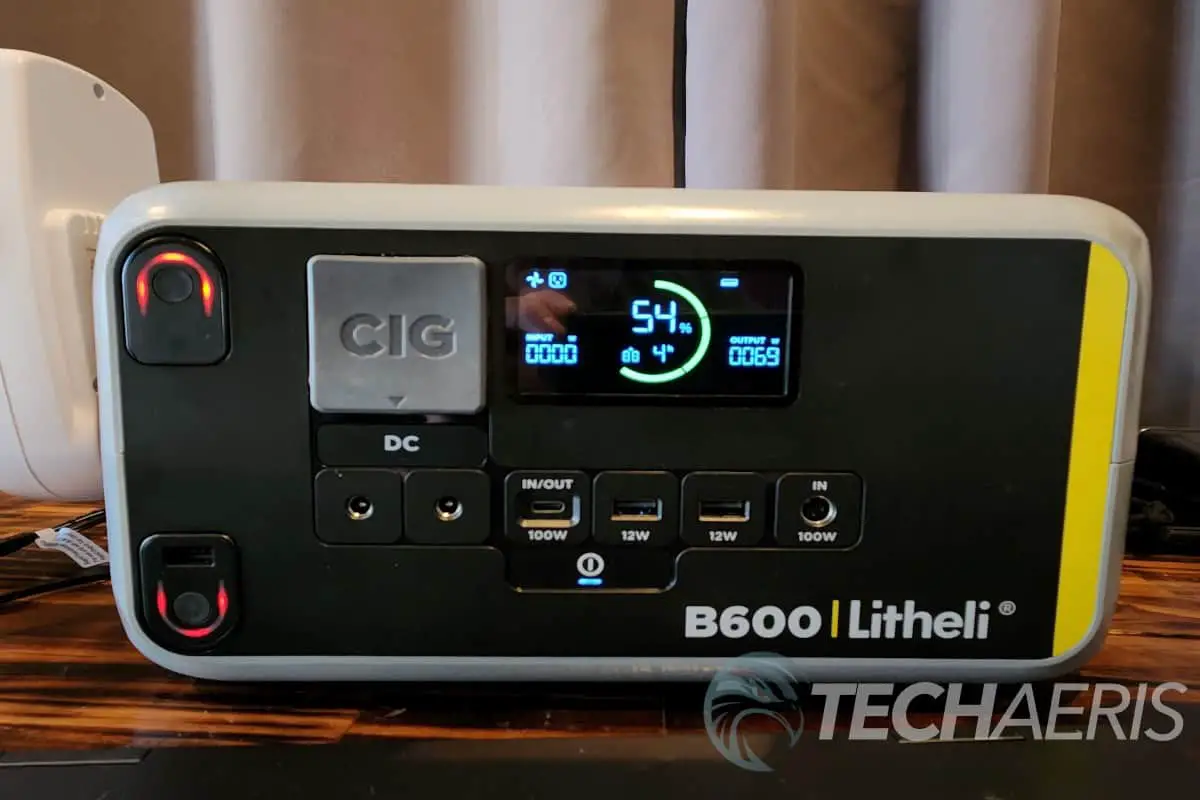
The front of the unit is where most of the business happens. On the left side, you have 2 U-Battery ports that your U-Batteries will slide into. I’ll get into more detail on those shortly. Next, you have your DC cigarette lighter-style plug that is covered by a rubberized flap. Below that, you find two DC5521 output ports. Continuing across the same row is a dual-purpose in/out USB Type-C PD port. This charging port is used to connect it to the 100W power brick. Next, you have a pair of USB-A ports and, finally the DC 100W max input port for the solar connection and connection from the vehicle charger.
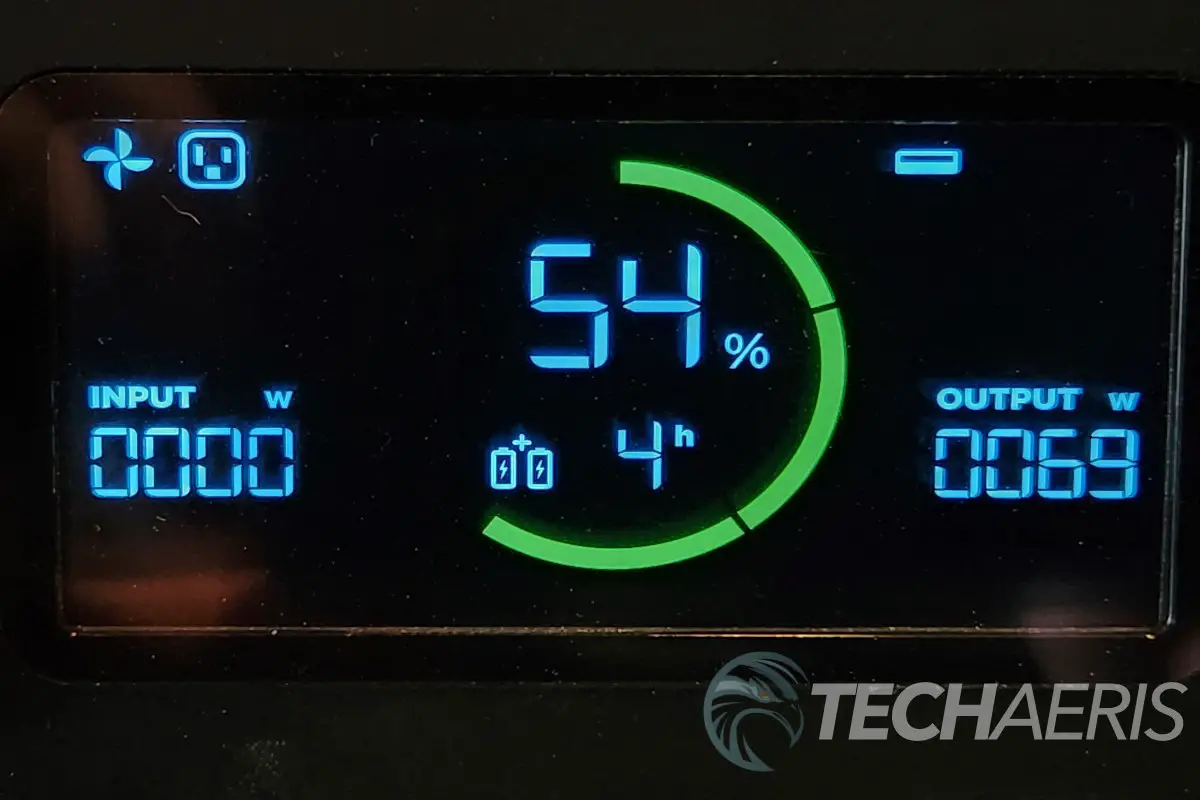
In the top center, you have a very crisp and clear display. Litheli made the battery percentage fairly large and is encompassed by a yellow ring graph that is segmented into 5 parts, or roughly 20% per segment, of the remaining power. Just under the remaining battery percentage, you will find an estimated time until the battery is depleted. You have your total input and output wattage displayed at the bottom on opposite corners. There is a slew of other various icons across the display that represents your U-Batteries, fan, AC/DC, and errors.
Let’s talk about that U-Battery for a minute. As I said, they reside on the left front of the Litheli Power Hub B600. They slide into place and are spring-loaded, much like an SD card on a phone, or GoPro is. A quick push in, and the U-Battery pops out. Slide it back into the housing and push it in to lock it into place. Both the U-Batteries that the unit comes with have a small power button on the front to turn the battery on when you want to use it. When it is turned on, you will get a series of lights that make a U shape across the top. One of the units offers a single USB-C output port on the rear and a single USB-A output port on the front.
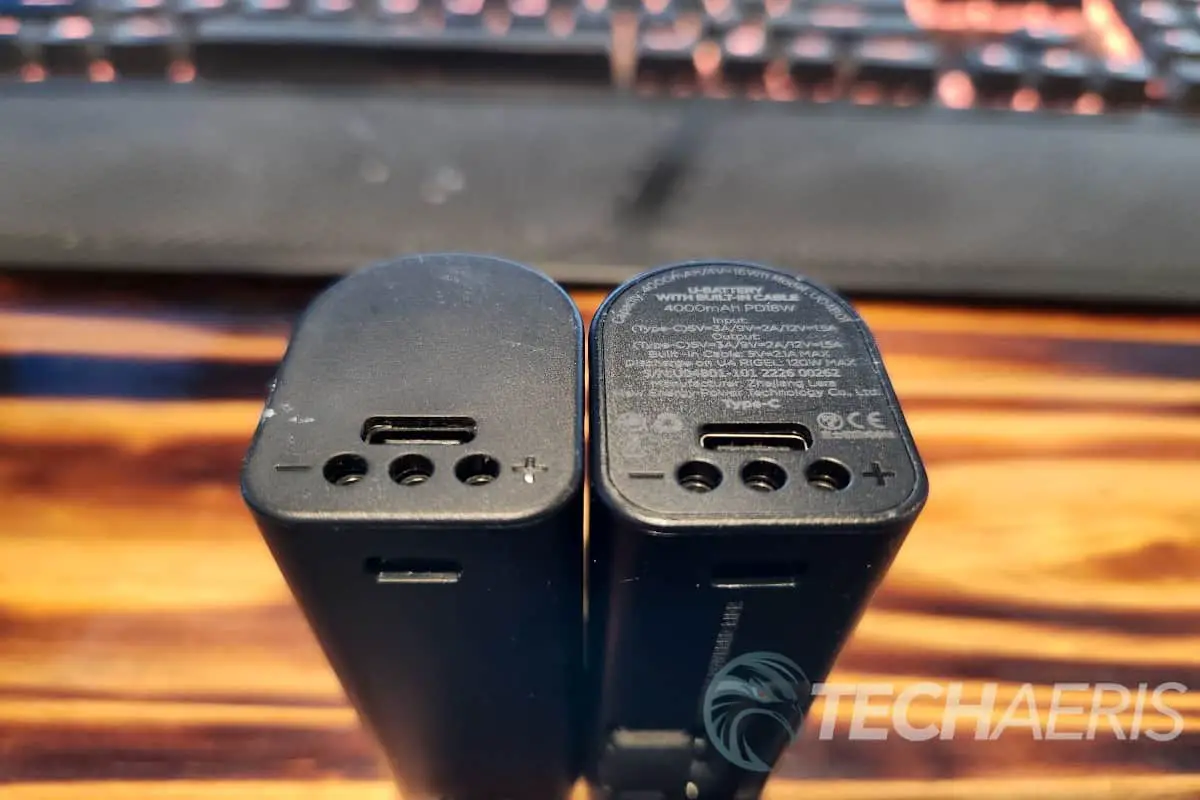
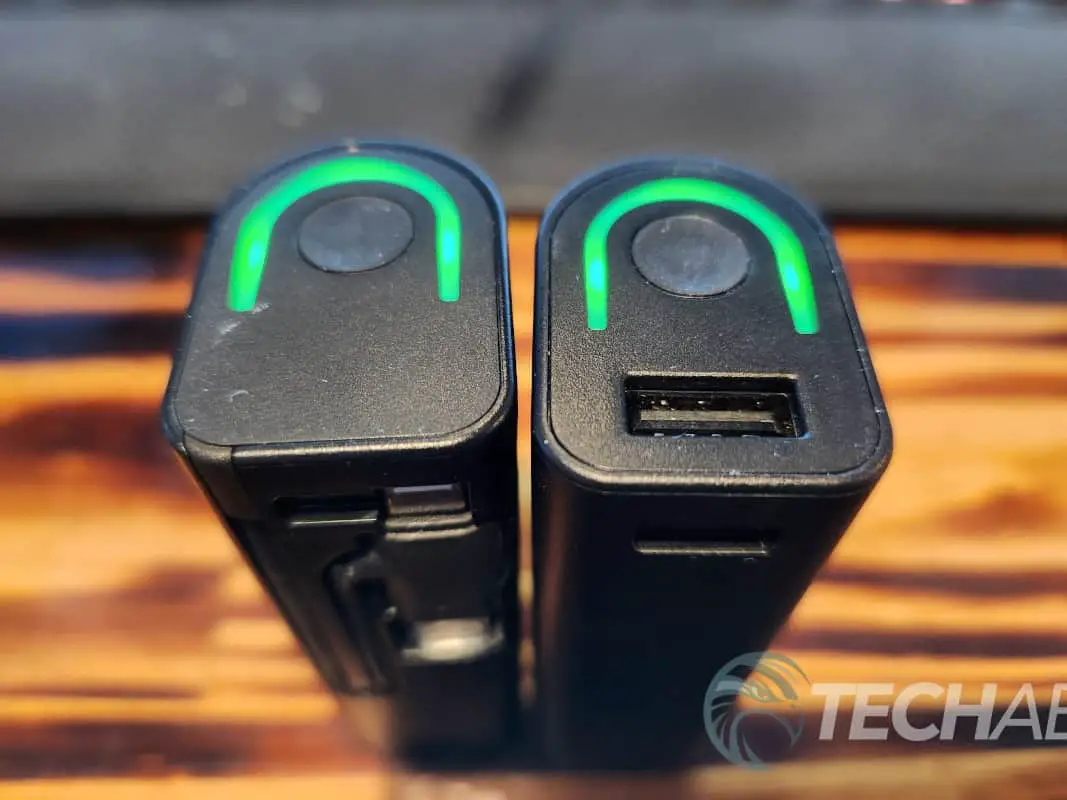
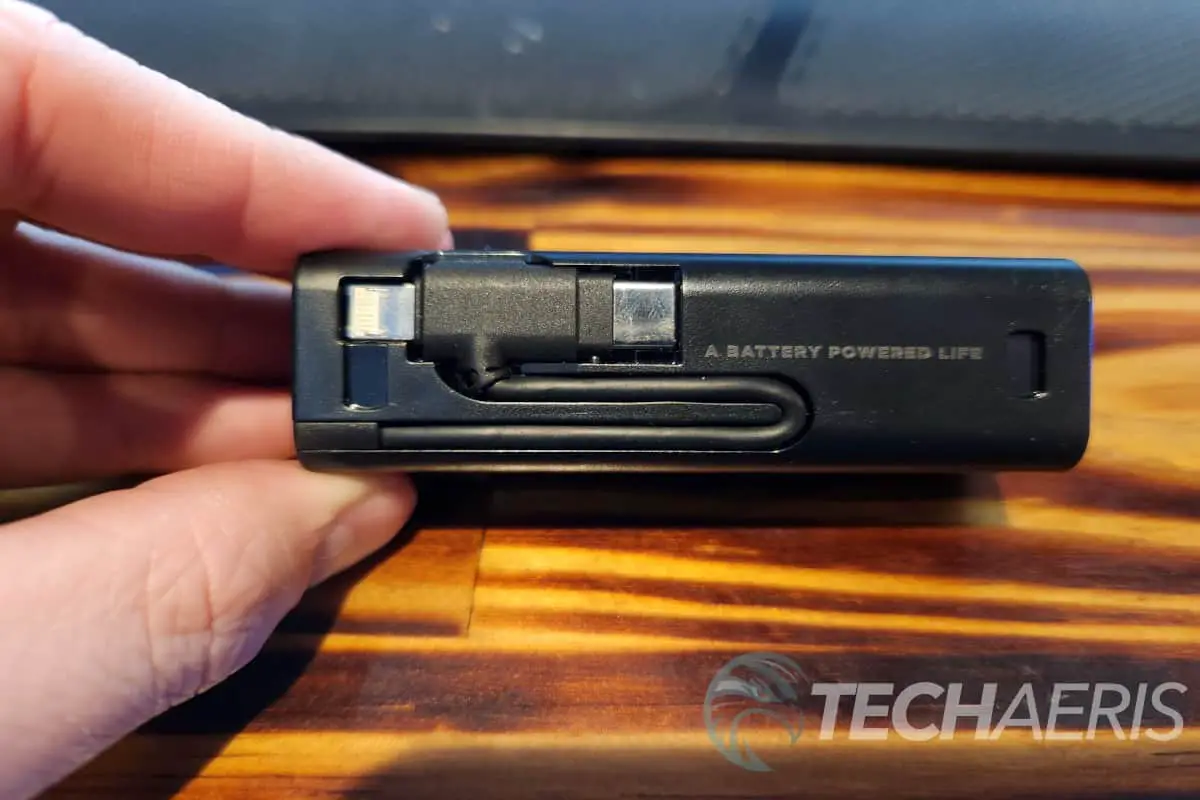
The other battery offers a single USB-C output port on the rear as well as a small connected cable on the bottom. The cable is a dual-ended hardwired cable that has a USB-C tip and a Lightning tip. The addition of the U-Battery offers a little more flexibility to the B600 from a design and functionality standpoint. A small removable battery to charge up your phone, tablet, headphones, or whatever you have that can charge from a USB is pretty nice. It lets you be a little more mobile without being tethered to the larger unit. They also add 32Wh of power to the B600, giving a bump from 562Wh to 594Wh. They serve one more purpose, though, they are the batteries that Litheli uses for their U4 product line of accessories. I’ll give you a look at the Litevac cordless handheld vacuum that Litheli sent over to test later in the review after we tackle the B600, Solar Panel, and stand.
Ease of Use
Using the Litheli B600 is pretty straightforward, much like any other solar generator/power hub. Most of your ports are clearly labeled with wattages and if they operate as input, output, or both. They didn’t label the DC5521 ports that are on the front for some reason. They are both output ports and run at 136W (peak), 13.6V-10A. Litheli doesn’t send cabling or connections that run on the DC5521 ports, either.
Powering the unit on takes a simple long press of 3 seconds to the power button found on the front just below the PD port. Once powered on, a tap of the AC or DC buttons is all that is needed to have power pushing out to the various ports and outlets and to charge the U-Batteries. I did discover, though, that the B600 is a little smart though; if it is powered off and you connect something to the PD USB-C port, it will start charging your device.
There is no app or wireless connectivity with the Litheli B600 limiting your interactions to being physical.
Performance
I ran a variety of devices on the unit to see if the stated performance numbers matched up. To see if the AC output readings are accurate, I used a Mecheer Watt Meter. Running low-wattage devices, like charging a walkie-talkie, resulted in no output readings on the B600 but was showing 3 watts on the watt meter. Charging my laptop gave us 61 watts of output on the display and 65 watts on the watt meter.
A wide variety of consumer electronic devices shouldn’t have an issue running or charging on the unit, even if you use all the ports simultaneously. At one point, I ran the vacuum, charged the walkie-talkie, charged my laptop, and charged 2 Samsung phones, and the B600 didn’t fail me.
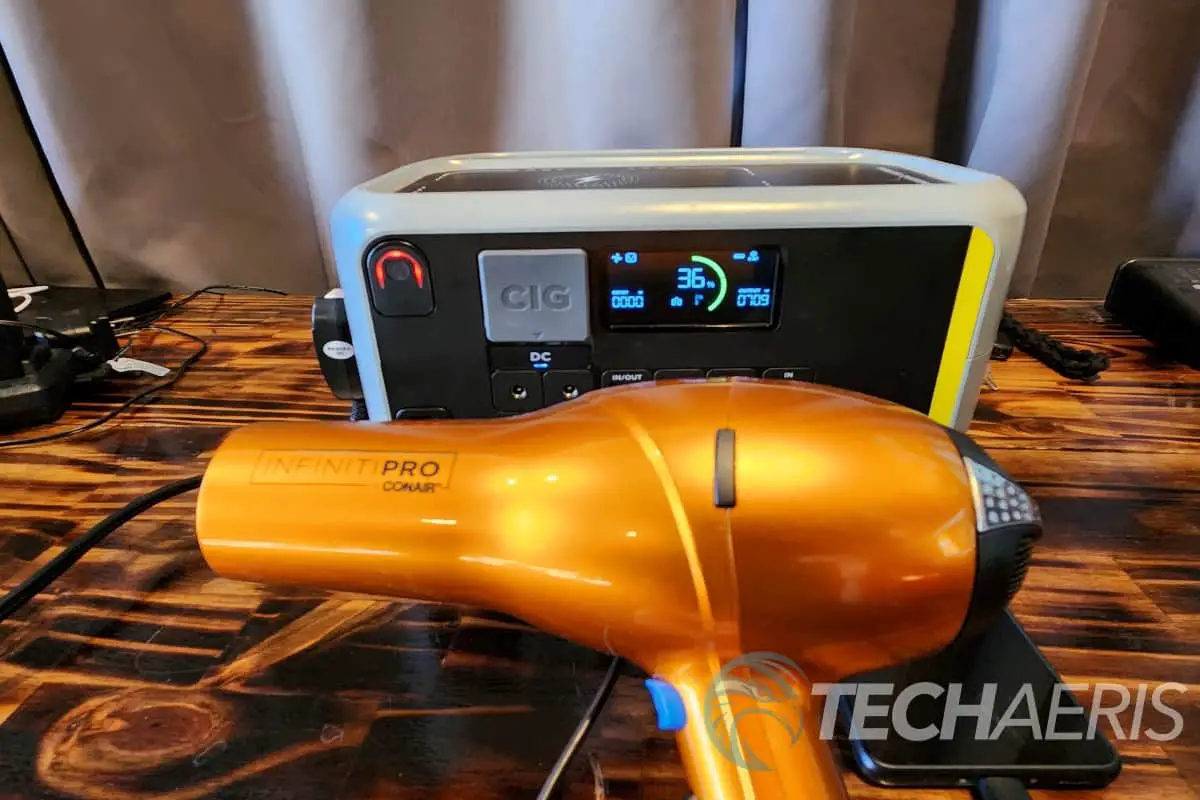
I ran the Shark vacuum for about 20 minutes and vacuumed the carpet in my room without issues at 642 watts. Next up was the Hair dryer test. On medium heat and high fan, my wife’s Conair hair dryer registered 674 watts with a Samsung phone and the 2 U-Batteries charging. When I flipped the switch to high heat, the hair dryer struggled, and the B600 shut down the AC output and registered “Err Overload” on the screen. I did manage to get the unit to register just over 700 watts for 15 minutes without fail, which is slightly higher than the rated 600 watts. I assume it would have run just fine until the battery was depleted.
I gave the unit a full charge and discharge multiple times. Each time the unit’s display showed 0% when it powered off. Other brands on the market have powered down with 1%-5% remaining, leaving you with a little power to spare to protect the batteries; that is not to say that there isn’t a small reserve of power in the system, just that the unit reports 0%.
Litheli’s recharge statistic is accurate at roughly 6 hours from the AC charger pulling in 92-93 watts as opposed to the full 100 watts that it says it can pull. In my charging tests from a standard wall outlet using the provided charge cable and block, it charged from 0% to 100% in roughly 6 hours and 5 minutes. It charged up in roughly 5 hours and 50 minutes when I removed the U-Batteries. They do take a small draw on the unit while charging.
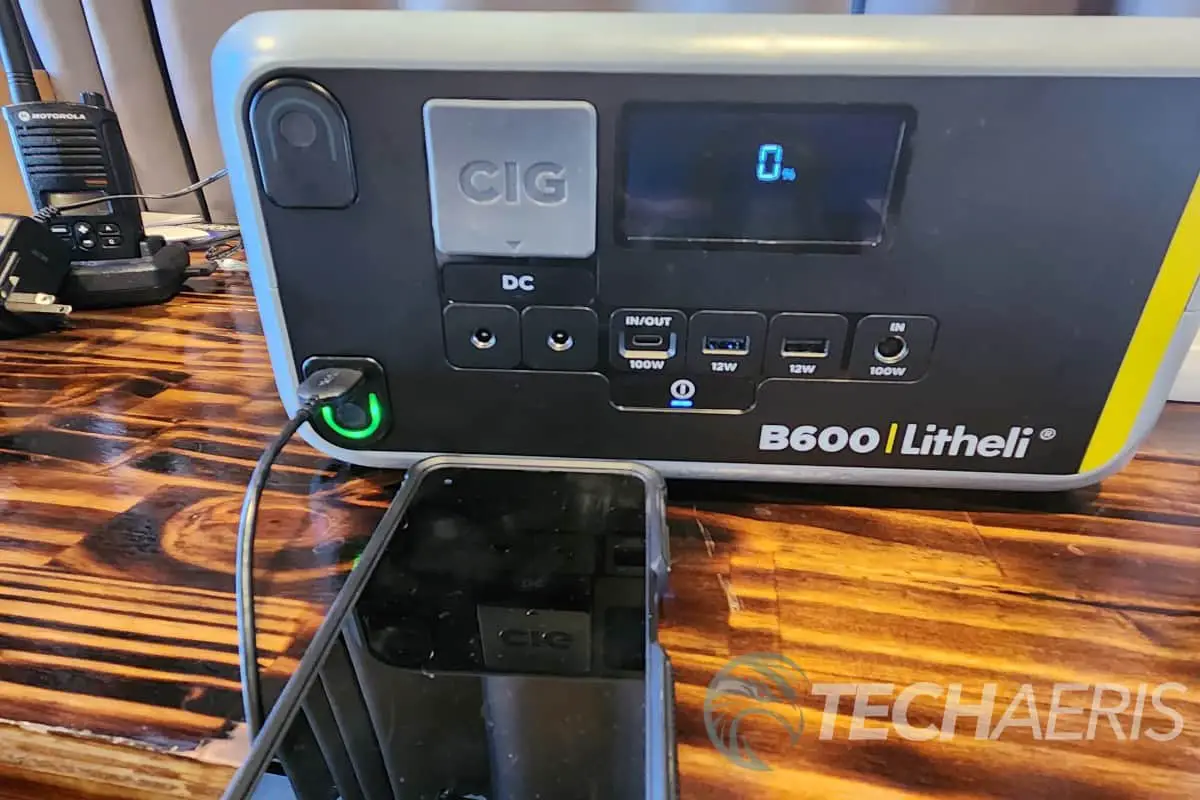
Interestingly enough, the U-Batteries remained charged when the B600 was completely discharged. The one U-Battery with the USB output port on the front was fully usable while it was still connected. That means they do not feed into the B600 as I had anticipated but rather are separate batteries that charge up using the B600 power. All that means is that they don’t give you a few more minutes of run time but are fully charged and available as portable battery packs. In an emergency having something to charge your phone or USB-powered device is nice.
Battery Life
Litheli chose to use Li-ion NMC battery chemistry. That is the same battery chemistry that Jackery and Goal Zero also use. You can expect to get around 500 full charges from 0% to 100% before the B600’s battery capacity will be 80%. If you charged and discharged once per day, you are looking at 1.3 years before you see a reduction in battery capacity. Most people won’t be using the Litheli B600 to that degree. An average weekend camper will get many years of service out of the unit.
The battery capacity is listed as 562Wh of power. If you are new to power stations, Wh stands for Watt Hours. Simple explanation, if you have a device that lists itself as 50 watts, say a projector, that is 50 watts per hour. If you were to run that projector on the B600, you’d expect to get 11.24 hours of use before the B600 ran out of power. That number is simply 562 / 50 = 11.24. While technology is pretty impressive, you don’t actually get to use the entire 562Wh of power, especially when running off the inverter. The inverter will use some of the available power to convert the battery power (DC) to AC power, and you will lose some power to the rest of the electronics and heat. Most likely, you’d be looking closer to 9.5 to 9.75 hours of run time before your B600 was out of juice. Litheli states 9.6 hours in their documentation. That would equate to about 475Wh of power out of the 562Wh. Roughly 85% of the battery power is usable by your device. That usually increases a bit when you switch to DC outputs vs. AC outputs.
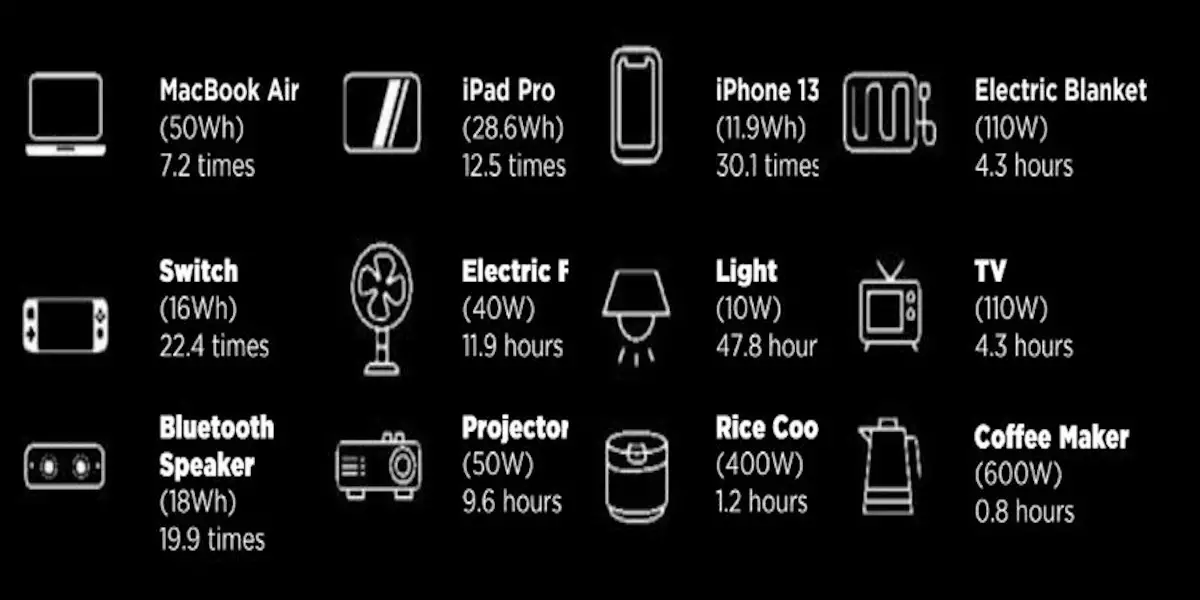
Your actual consumption times will vary by device, the number of devices connected if they are being used while charging, etc. For instance, Litheli states that if you charge your iPhone 13 with the B600, it can charge it 30.1 times. The straight math doesn’t add up. If we stayed at 85% or 475Wh of usable battery, then you would be at 39.9 times at 11.9Wh of the draw. If the phone is on and being used, then you are going to get fewer charges out of it, and 30.1 recharges is probably pretty close. Accounting for those variances will help you decide if you are buying enough power to run what you really need it to run.
Litheli 100W Portable Solar Panel
Specs
- 100 Watts
- Conversion Rate: 22%-23%
- Load Voltage: 20V
- Load Current: 5A
- Open-Circuit Voltage: 24V
- Short-Circuit Current: 5.5A
- Waterproof Rating: IP67
- Weight: 8.91Lbs
- Dimensions: 14.37 x 22.4 x 1.18 inches when closed
- Connection: MC4
Along with the Litheli B600, we were able to take a look at their 100W portable solar panel. It comes inside a very well-made cloth and what feels like a PVC bag. The dual zippers go around 75% of the bag, making it really easy to get the panel in and out of.
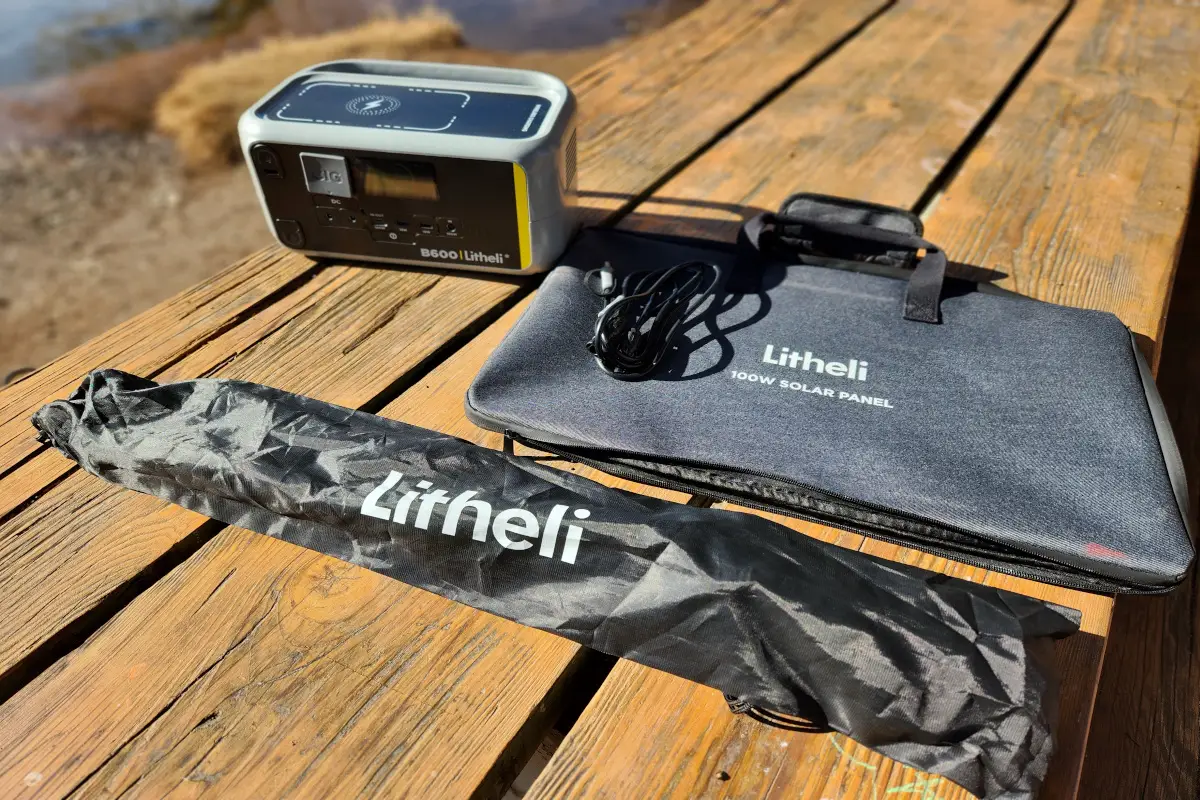
When you remove it from the bag, you must unsnap 4 buttons, 2 at the top and 2 at the bottom. The panel folds out into 4 panels. The panel itself is a Monocrystalline silicon cell solar panel with an ETFE (Ethyl Tetra Fluoro Ethylene) lamination. On the right side of the panel, you will find your standard MC4 cable connections for connecting it to and compatible device. I’m happy to see the more universal MC4 connection used rather than a proprietary connection.
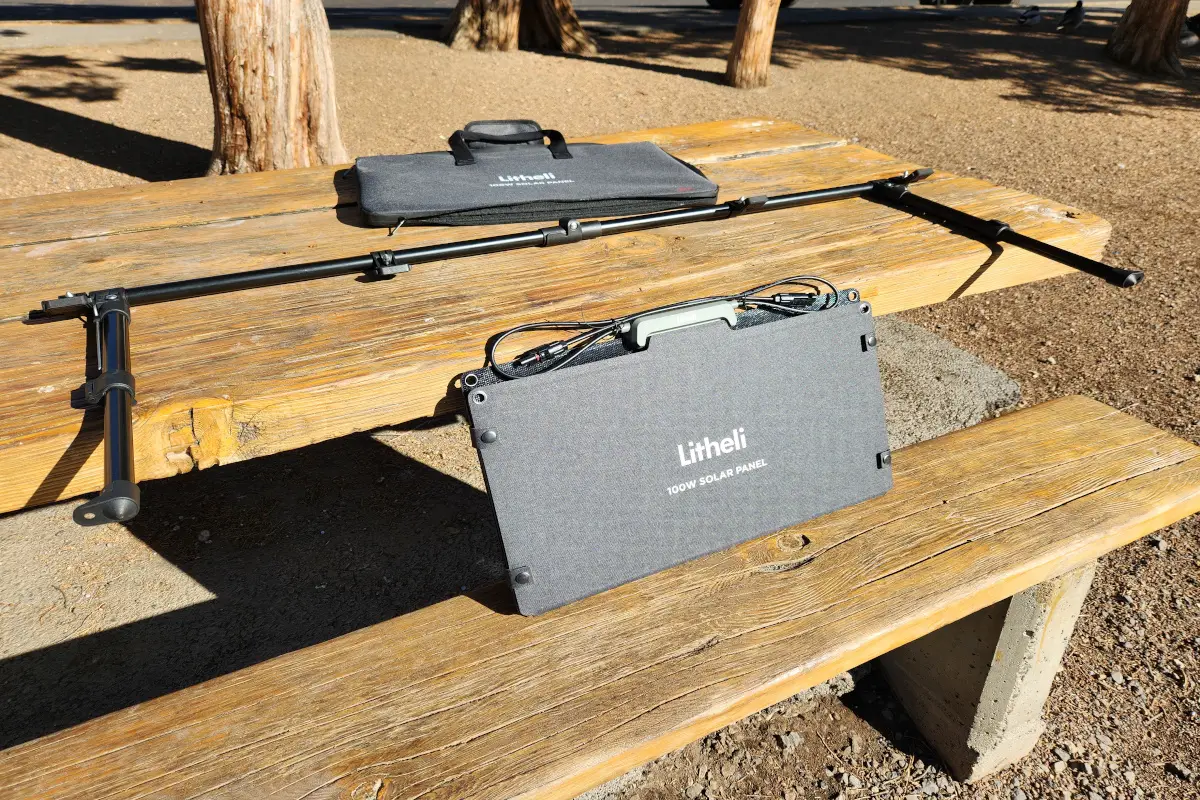
With your panel purchase, you also get a portable stand that is collapsible inside its own separate bag. It is not required in order to use the panel, but it sure does make using it nice and easy. Essentially it is a set of telescoping legs and a stabilization bar that goes across the top. There are 4 protruding spikes that the panel grommets will slide over. Simply close the cap to secure the panel in place. They are spring-loaded, and you will need to pinch the sides to release the panel. The setup only took me a minute or two.
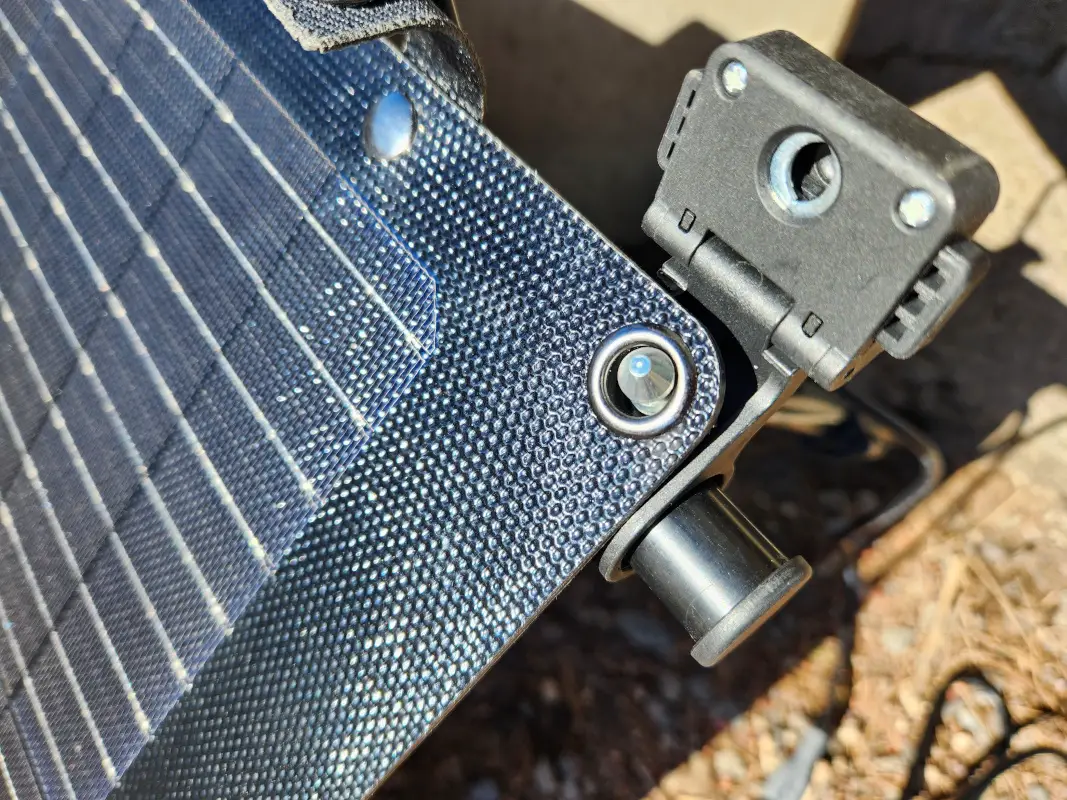
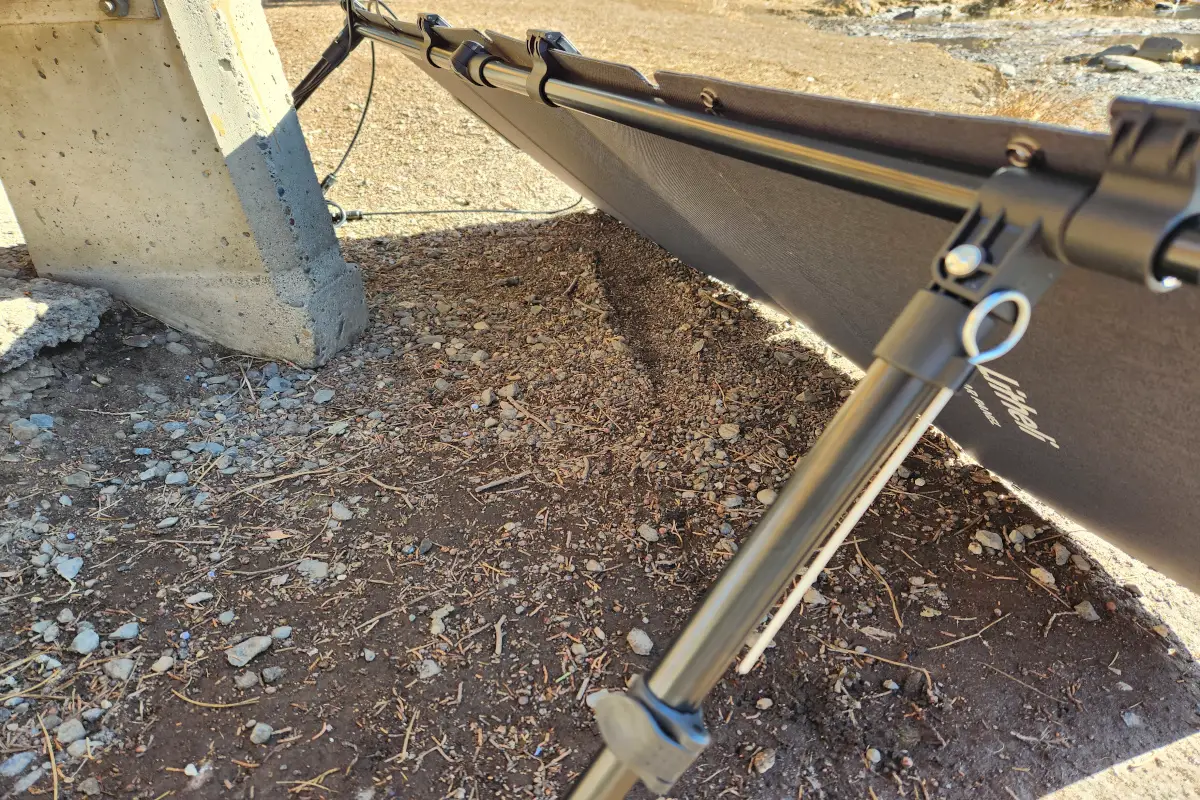
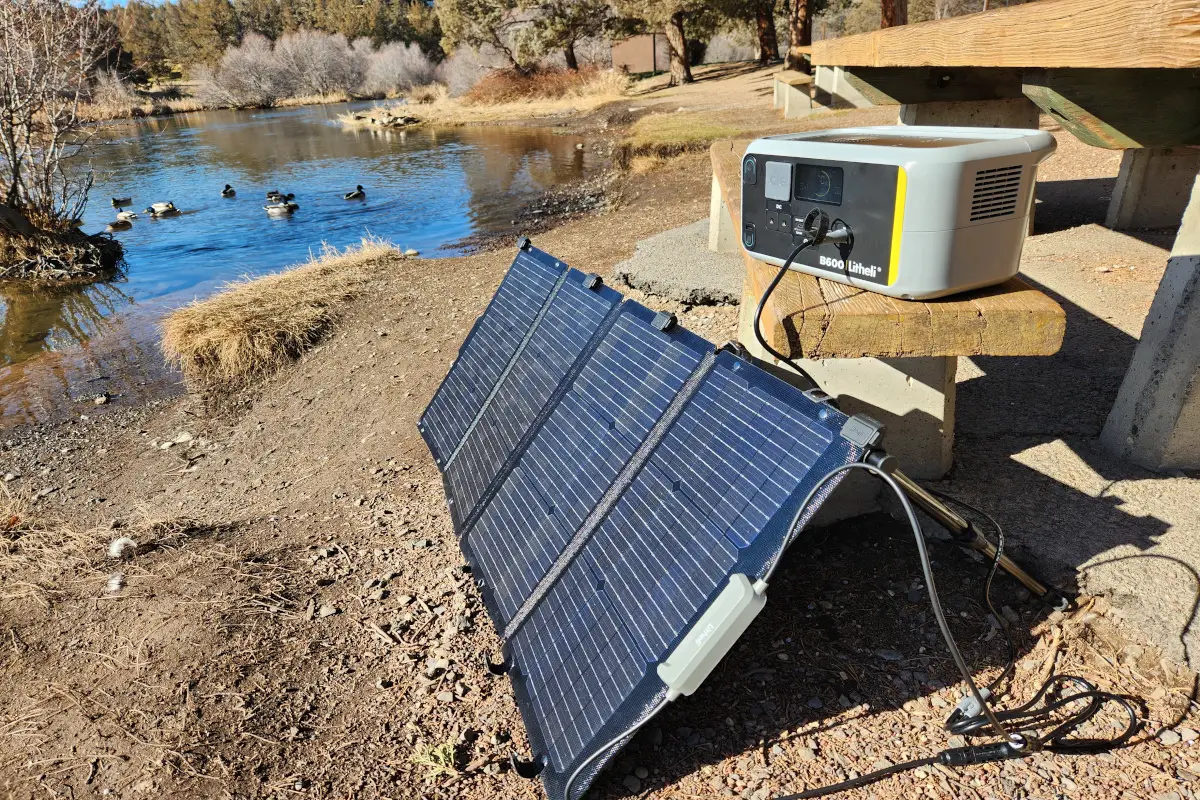
The telescoping legs give you the ability to easily adjust the height and angle of the panel to capture the most sun possible. Litheli gave some good thought to its design. If you look at the image above, you will see a small metal stake with a loop on the end. There is one on both sides. Those are so you can stake the legs in the ground. Litheli could have easily just tossed them in the bag, but instead, they incorporated a spot for them to attach to the stand.
Living in Oregon in the thralls of winter, my solar testing was a bit limited. We are still seeing snow storms right now, and it is March 25th. The few days I did have sun, I was able to get the panel setup and register around 75w of input power. That is what one would expect from a 100w panel in less-than-ideal conditions. If the B600 were completely dead, it would take more than the 6 hours listed to regain a full charge. Ideally, you would only be needing a 50% or less top-off to get the most out of the solar charging ability of the B600.
LiteVac
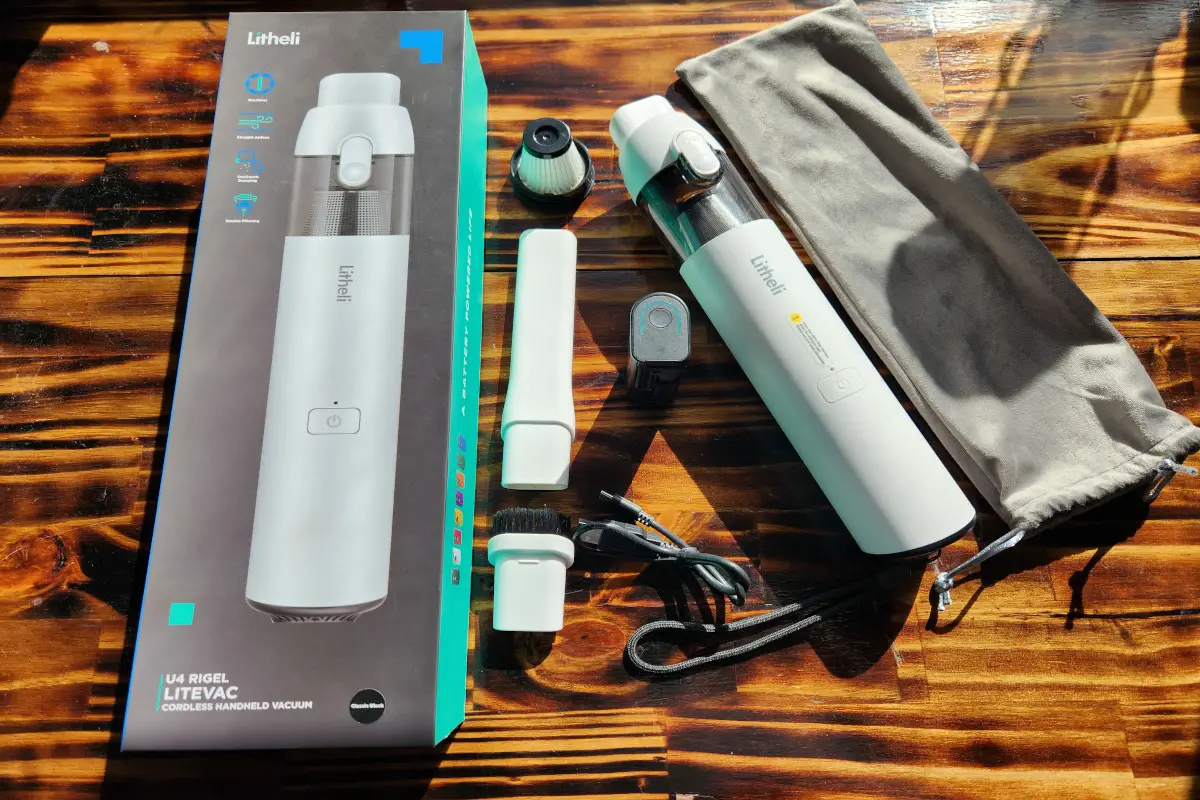
This is where things get a little different. Most portable power stations deliver power to your devices and call it a day. The Litheli B600 offers charging ports for its U-Battery eco-system. This eco-system allows you to drop the U-Battery inside a variety of specially designed tools. Currently, they list a cordless vacuum mop, a cordless wet-dry vacuum cleaner, and a handheld vacuum cleaner. From the packaging, it appears as though there will be a drill, hot glue gun, and massager eventually. They sent us the handheld vacuum cleaner to try out so we could really tie the whole system together.
Specifications
- Voltage: 4V
- Battery Capacity: 4000mAh
- Rated Power: 100W
- Motor: Brushless
- Dust Cup: 0.1L
- 2 Speed Levels
- One touch dumping
- Straight Airflow
- Double Filtering
In the box
- Litevac Cordless Handheld Vacuum
- Charging cable
- Extra filter
- Brush adapter
- Long Vacuum Adapter
The Vacuum comes inside a nice soft carry bag, but the bag isn’t large enough to tuck the additional components in. It measures in at just about 12 inches and weighs just about 3/4 of a pound.
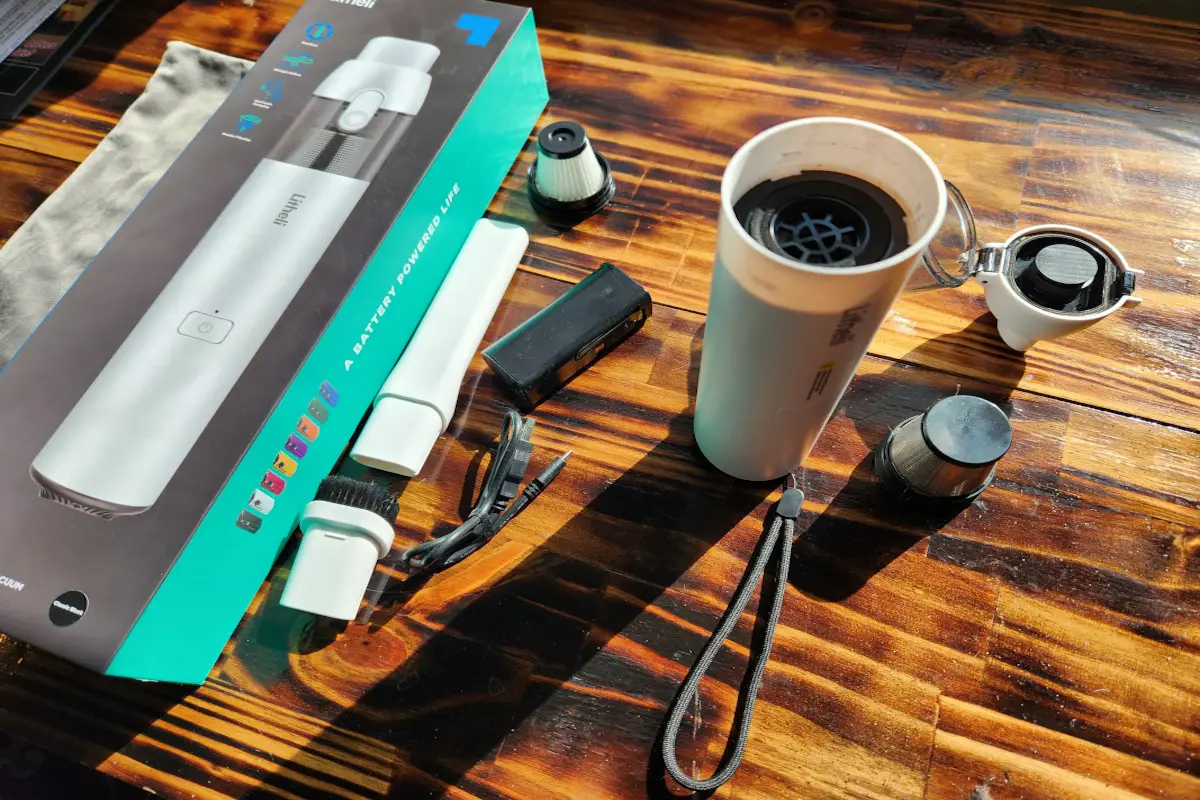
Operation of the vacuum is pretty straightforward. On the rear of the vacuum is where you slide in the battery to give it power. You feel it click into place via a small tab that holds it into place. A little push at the bottom of the battery releases it.
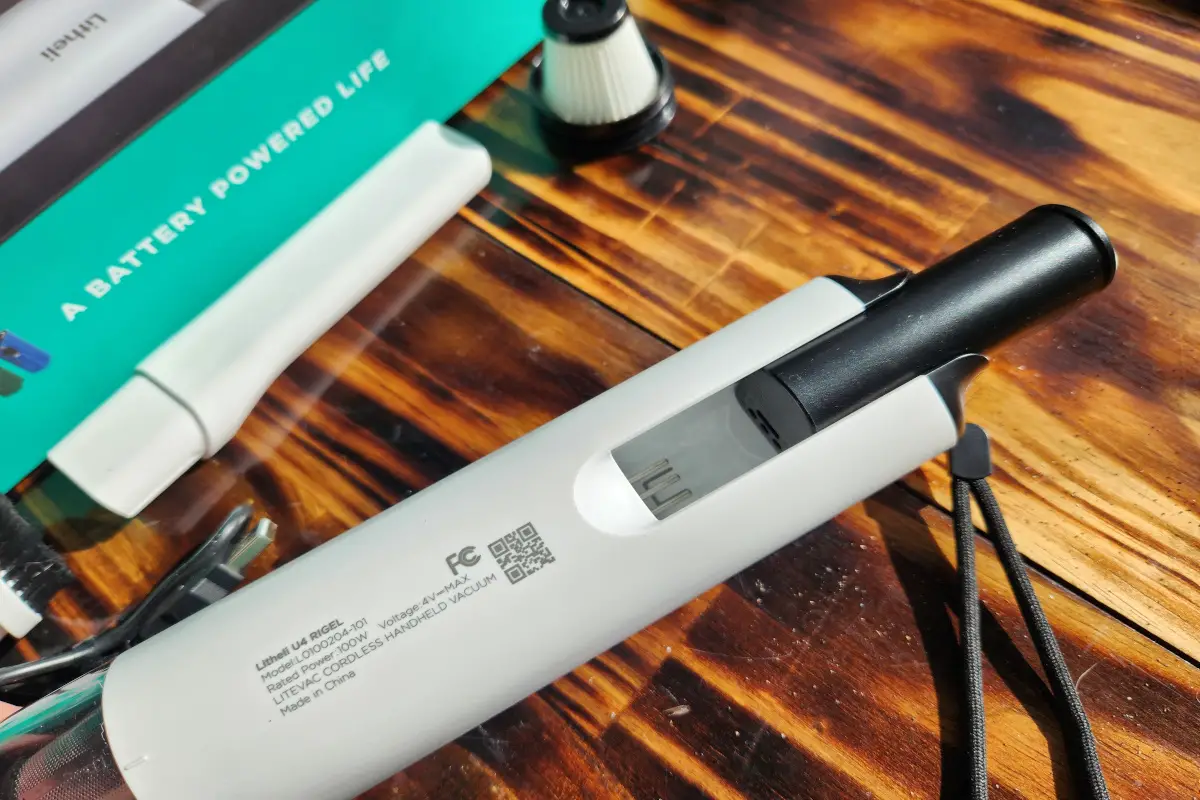
You will find a power button partway down on the cylinder. The vacuum offers two speeds and is controlled by simply pressing the power button.
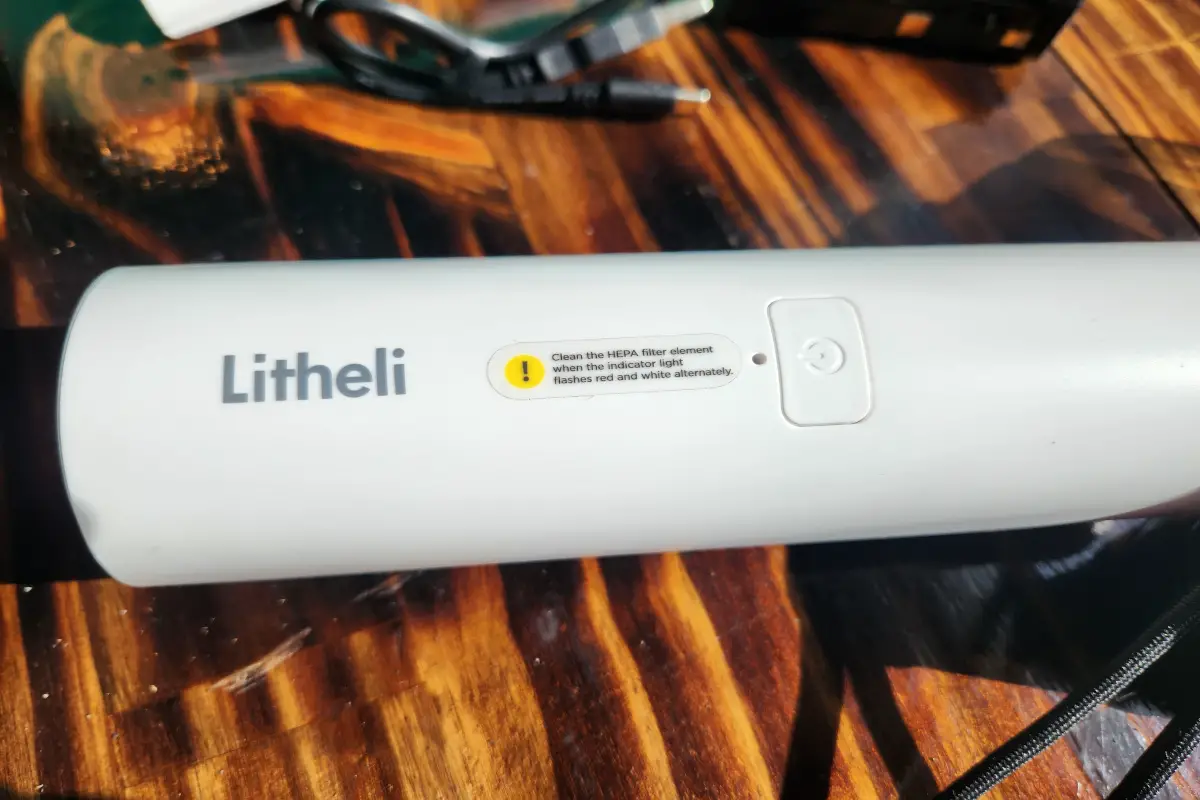
The business end has a single button release to let you empty the dust cup and is spring-loaded. Be over the trash if you plan to push the button, as it opens quite well.
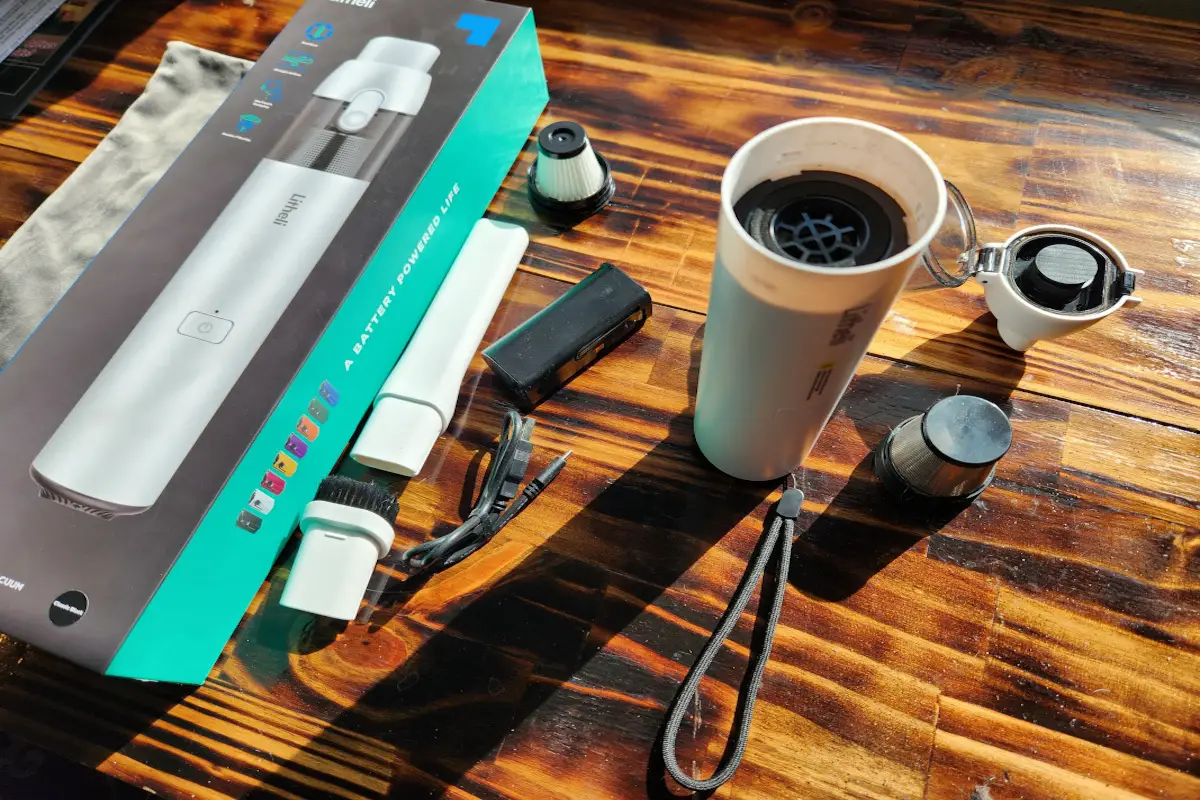
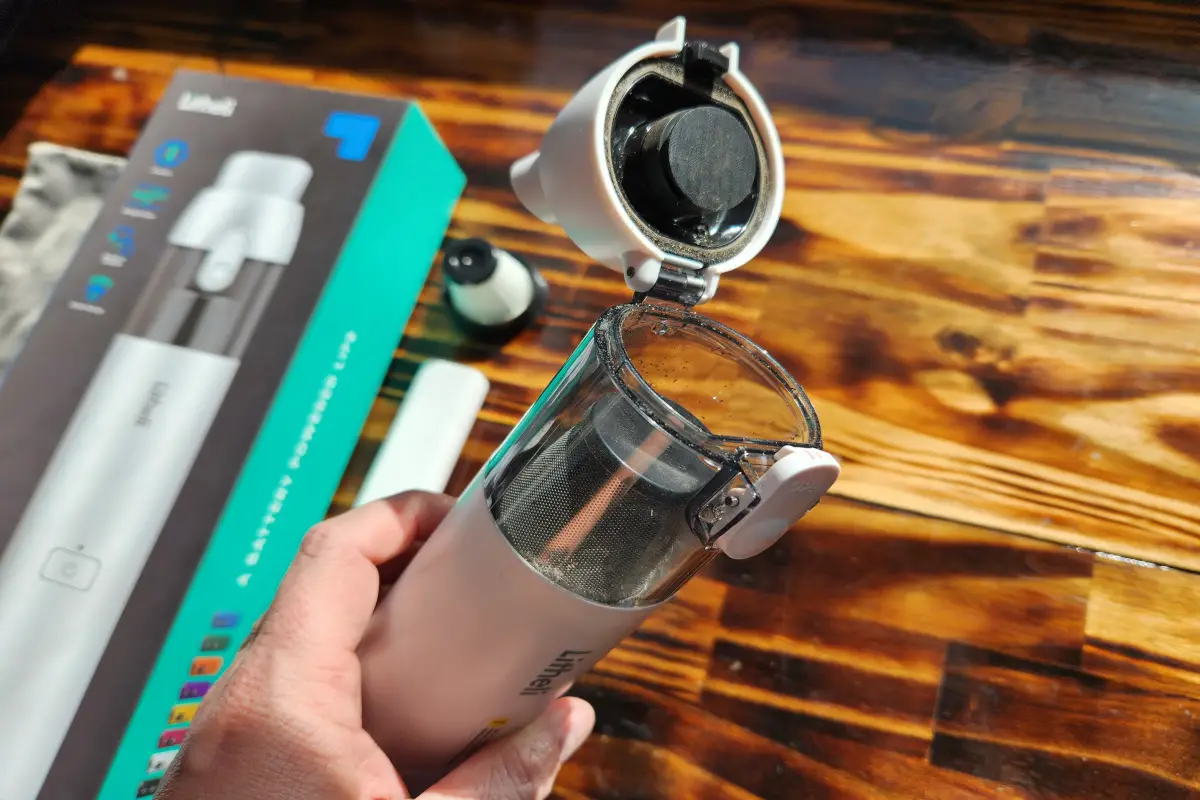
To change the HEPA filter or get any built-up gunk, you simply twist the cup until the small line lines up with the unlock symbol. Then it is a matter of rocking it back and forth a little to get it to open up. Once removed, you have access to the replaceable HEPA filter and the metal pre-filter.
As for run time goes, a fully charged battery on low speed should power the vacuum for 10 minutes and on high for 20 minutes. The size of the collector makes sure you are running it for shorter times. You aren’t going to clean your whole house with it, but quick clean-ups, cleaning crumbs from your keyboard/desk, getting the junk out of your seat in your car, etc. I used it to get around my keyboard and monitors. I also vacuumed out the seats and crevasses in my truck. On the low setting, I saw 20:18 before it died. I ran a new battery at high and saw a run time of 11 minutes, making Litheli’s claim pretty spot on. I wasn’t cleaning the hole time, so you may experience short times while putting strain on the motor.
Its small size makes it perfect to have in a tiny home, van, camper, or overland rig. I think keeping the B600, the solar panel, and the vacuum in my truck will make for a pretty powerful summer.
Price/Value
There are a lot of things to consider when we look at the price and value of a product. I was originally a bit disappointed with the charge times and the battery chemistry. Looking at the competition, though, they are spot on and, in this case, offer more options than they do. The Jackery Explorer 500 is the closest counterpart, and it offers a little less power, fewer AC plugs, no USB-C PD port, no wireless charging pad, no U-Battery expansions, and is the same $499. The Jackery also states 9.5 hours to charge fully from AC. Litheli wins in direct comparison. However, Litheli is selling the B600 for $369 via the Litheli website and Amazon at the time of writing this saving you $139 over the Jackery Explorer 500 currently.
The solar panel lists $299 and is on sale for $269, but if you bundle them both up on amazon, you can get the Litheli B600 and solar panel for $599 after a $150 coupon. Otherwise, you are looking at $749 for the pair at regular Amazon retail pricing.
The LiteVac retails for $79.99 on Litheli.com but is also on sale for $39.99. It is quite useful even as a stand-alone purchase. I know I saw it land on Amazon for the same $39.99, and they had a $20 coupon for a short while.
Wrap Up
Overall I was really impressed with the Lithelli B600 and its innovative U4 Battery system. It really offers some expandability that other brands are not leveraging yet. The unit is small, lightweight, and does everything that Litheli said it would do. I would love to see it charge faster, but an average person will be using part of the power most of the time and not discharging to 0% like myself. I would have preferred LiFePO4 batteries over the Li-ion NMC for the longevity of the battery chemistry, but 500 cycles to 80% are still going to outlast what most users will ever need it for. What I am most interested to see is what small U-Battery devices the company puts out to pair with it going forward. The larger Mop and Vacuum are certainly interesting on their own already.
The 100W solar panel is just about the perfect travel companion to charge the B600 or any other solar generator that uses MC4 connections. The carry case helps protect the exterior of the panel and makes it very portable. The solar panels stand is not hard to set up and does let you prop the panel up at a wide variety of angles to get the most sunlight you can. I would have liked to have it integrated into the panel to reduce the space and accessories you would need to carry. The stand isn’t very large and does have its own bag that still makes it easy enough to toss inside a vehicle, though.
The LiteVac is a great travel companion for keeping your tents, van, truck, etc., clean. It offers enough suction to clean up dust, dirt, leaves, and food while not taking up a ton of space. Since the battery is charged inside the B600, you don’t have to remember to charge up another device separately. Simply toss the battery in the charging slot and grab the spare.
I always leaned towards other brands and battery technology, but the Litheli B600 is certainly worthy of researching if you are a weekend warrior or looking for a little power to supplement your current gear.
Last Updated on March 13, 2024.

